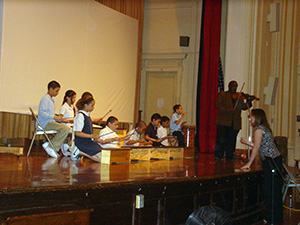



Residency Programs for Colleges and Universities
 In addition to his concert performances, Blake offers 2- to 5-day residencies as a part of his programs. Because of his extensive background as an educator, colleges and universities nationwide seek Blake's services. He presents a variety of programs that enrich the experiences of the entire campus and general public alike, which makes him more valuable as an artist.
In addition to his concert performances, Blake offers 2- to 5-day residencies as a part of his programs. Because of his extensive background as an educator, colleges and universities nationwide seek Blake's services. He presents a variety of programs that enrich the experiences of the entire campus and general public alike, which makes him more valuable as an artist.
His lectures include:
1) The History of the Violin in African and Afro-American Cultures
2) The History of the Violin in Jazz
3) Afro-American History Through Music
His workshops for musicians include:
1) The Art of Improvisation
2) Improvising for String Players
3) Surviving as a Musician
Residency Programs for Middle & High Schools
A four-part series
Afro-American History Through Music
This is a 3- to 4-day residency that provides the teachers with a study guide to prepare themselves and their students prior to the residency.
The guide includes:
a) program description,
b) program objectives,
c) a pre/post performance knowledge survey,
d) websites for student activities & information,
e) a brief description of Afro-American musical styles,
f) answers the question: “What is Jazz?”
g) a brief bio of John Blake Jr.,
h) a listening list,
i) a description of “The Harlem Renaissance”.
Assembly Programs (Pre-School thru High School):
The John Blake Jazz Quartet
Jazzin’ Round the World
Description: American jazz, as we know it today, is an amalgam of musical forms from many parts of the world. As the population of our country has expanded to embrace manycultures, so has American jazz experienced that same expansion, continually changing and incorporating the music of our new Americans into itself.  Through participation and demonstration by the John Blake Quartet, students will have an opportunity to hear first hand some of the major changes in jazz in the past ten years, and learn about the cultures that have been the impetus behind these changes.
Through participation and demonstration by the John Blake Quartet, students will have an opportunity to hear first hand some of the major changes in jazz in the past ten years, and learn about the cultures that have been the impetus behind these changes.
Objectives: After a Jazzin’ Round the World performance, students will 1) be able to describe the difference between drums and percussion, 2) be able to identify each of the 6 cultures included in the program with the music played, and 3) be able to locate on a map the countries that have fused with traditional American jazz to create these sounds.
Preparations Guide 1) Includes a vocabulary list for teachers 2) A brief explanation of styles and instruments used in the performance
A Jazz Journey for Youth
 Description: A program designed to give students of all ages insight into the origins and performance of the great American art form — jazz. Audience participation engages the students through 1) singing; 2) clapping; 3) call and response; 4) jazz arrangements of familiar cartoon and movie tunes, and the standard works of great jazz composers; 5) an introduction to the great historical figures in jazz — Duke Ellington, Dizzy Gillespie, Louis Armstrong, and others; and 6) time for questions and answers, which completes this very interactive program.
Description: A program designed to give students of all ages insight into the origins and performance of the great American art form — jazz. Audience participation engages the students through 1) singing; 2) clapping; 3) call and response; 4) jazz arrangements of familiar cartoon and movie tunes, and the standard works of great jazz composers; 5) an introduction to the great historical figures in jazz — Duke Ellington, Dizzy Gillespie, Louis Armstrong, and others; and 6) time for questions and answers, which completes this very interactive program.
Objectives: Through an interactive approach: 1) to explore the roots of jazz and its various styles; 2) to learn how the basic elements of music — rhythm, melody, and harmony — are utilized in the jazz idiom; and 3) to understand the origins and use of improvisation in jazz, and its importance in the development of jazz as a unique musical form.
Preparations Guide 1) Includes a vocabulary list for teachers 2) A brief explanation of jazz styles and key musicians
PennPAT Roster Artist
Because Blake is a PennPAT roster artist, non-profit presenters in certain regional states are eligible to apply for artist fees support. Historically, about 70% of all PennPAT presenter applications have been funded with grants ranging from 30% to 50% of artist fees, travel, and lodging.


